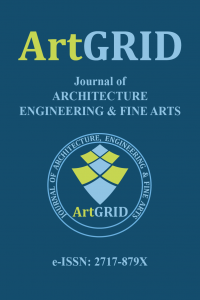GLİSEROL İLE STABİLİZE EDİLMİŞ TOPRAK KAPLAMALARIN NEM DİRENCİ
Gliserol, alçı, sürdürülebilirlik, geleneksel yapı, nem
MOISTURE RESISTANCE OF EARTHEN COATINGS STABILIZED WITH GLYCEROL
Glycerol Glycerol, plaster, sustainability, traditional construction, moisture,
___
- Ávila, E., & Guerrero, L. (2018). El mucílago de Opuntia Ficus como estabilizante en recubrimientos de tierra. Memorias del SIACOT 2018, Antigua Guatemala: PROTERRA, 115-126.
- Betancourt, C., de Melo Prado, R., Castellanos, L., & Silva, C. (2016). Caracteristicas de la glicerina generada en la producción de biodiesel, aplicaciones generales y su uso en el suelo. México: Ediciones INCA, Instituto Nacional de Ciencias Agrícolas, 7-14.
- Guerrero, L. (2007). Arquitectura de tierra, hacia la recuperación de una cultura constructiva. Apuntes, 182-201.
- Guerrero, L. (2015). Recubrimientos de tierra compactada para la conservación del patrimonio arqueológico de México y el Salvador. Memorias del SIACOT 2015, Cuenca, Ecuador: PROTERRA, 233-244.
- Guerrero, L. (2016). El papel de la humedad y la compactación en la elaboración de recubrimientos de tierra. Construcción con tierra CT7, 11-22, Buenos Aires: Universidad de Buenos Aires.
- Kita, Y., A. Daneels, y A. Romo De Vivar. (2013). Chemical analysis to identify organic compounds in pre-Colombian monumental earthen architecture. TOJSAT, 3 (1):39–45.
- Lafuente, G. (2017). Glicerol: Síntesis y Aplicaciones. Madrid: UNED Facultad de Ciencias.
- Mattone, R., et Al. (2005). Uso de productos naturales para mejorar el comportamiento al agua de revoques a base de tierra, en Terra em Seminário 2005, Lisboa: Argumentum, 266–69.
- Mattone, M. et. Al. (2016). Stabilization of earthen plasters: Exchange of knowledge and experiences between Italy and Morocco. Journal of Materials and Environmental Science, 7 (10):3647–55.
- Mattone, M. et. Al. (2017). Experimentation of Earth-Gypsum Plasters for the Conservation of Earthen Constructions. International Journal of Architectural Heritage Conservation, Analysis, and Restoration, 11:6, 763-772, DOI:10.1080/15583058.2017.1290850.
- Minke, G. (2005). Manual de construcción en tierra, Uruguay: Fin de Siglo.
- Minke, G. (2013). Revoques de barro, mezclas, aplicaciones y tratamientos. Bariloche, Argentina: Icaria editorial. Normal 11/85 (1985). Assorbimento d’acqua per capillarità – Coeficiente di assorbimento capillare. Italia: CNR-ICR.
- Pérez, A.; Guerrero, L.; González, J. y Prado, R. (2017). Nopal mucilage as hydration agent for quicklime; extraction methods, Ge-conservación, 11: pp. 189-195.
- Pérez, N. (2009). Formulación de un mortero de inyección con mucílago de nopal para restauración de pintura mural. Tesis para la obtención del grado de Maestría. Tlaquepaque, Jalisco: Instituto Tecnológico y de Estudios Superiores de Occidente.
- Pérez, N. (2016). Los adobes arqueológicos de la Gran pirámide de Cholula. Tesis Doctoral de Ciencia e Ingeniería de los Materiales. México: UNAM.
- Stazi, F., A. Nacci, F. Tittarelli, E. Pasqualini, and P. Munafò. (2016). An experimental study on earthen plasters for earthen building protection: The effect of different admixtures and surface treatments. Journal of Cultural Heritage, 17:27–41. doi:10.1016/j.culher.2015.07.009.
- Torres, P., et. al. (2015). La baba y el mucílago de nopal, una alternativa natural para la conservación de acabados arquitectónicos de tierra. Revista Interdisciplinaria, INAH, 99: pp. 93-114. UNE-EN-16302
- Warren J. (1999). Conservation of earth structures. Oxford: Butterworth Heinemann.
- Yayın Aralığı: Yılda 2 Sayı
- Başlangıç: 2019
- Yayıncı: Hakan OĞUZ
ORMAN EKOSİSTEMLERİNDE KARBON DİNAMİĞİNİN TEMEL BİLEŞENLERİ VE PLANLAMADAKİ YERİ
Esra ACAR, Merve DAĞ, Rüya ARDIÇOĞLU
Gülşen AKIN GÜLER, Aslı ÖZÇEVİK BİLEN
GLİSEROL İLE STABİLİZE EDİLMİŞ TOPRAK KAPLAMALARIN NEM DİRENCİ
Lılıan GARCÍA-ALONSO, Luis F GUERRERO-BACA
İRAN'DA SÜRDÜRÜLEBİLİR MİMARİ YAKLAŞIMLI KONUT BİNALARININ SICAK VE KURAK ALANLARDA İNCELENMESİ
